PinotFile: 12.5 May 3, 2020
|
Joe Rochioli Jr: No Ordinary Joe. A History of J. Rochioli Vineyards & Winery
John Winthrop Haeger, Pacific Pinot Noir
 Joe Rochioli Jr. (referred to as “Joe” in this article) is a winegrower extraordinaire, the patriarch of Russian River Valley Pinot Noir farming. Ever humble but very proud, he has an indefatigable devotion to his vineyards. His personal history is marked by numerous remarkable achievements that inseparably link him to the history of Pinot Noir viticulture in the Russian River Valley. Joe’s family history begins with his paternal grandfather who was born in San Vito, near Lucca, in Northern Italy in 1874. At a very young age was left on a doorstep in town. The family that initially cared for him was extremely poor and eventually sent him to an orphanage. Since he had no name, the orphanage gave him the name “Michele Rocchioli” (“Mee-ke-le Ro-kee-o-lee”), a word that had no meaning in the Italian language. He grew up unadopted and became a cobbler. In 1896 Michel met Maria Assunta Catalani and married her in 1898. Joe’s father, Joe (Giuseppe) Rochioli Sr., was born to the couple in Northern Italy in 1902. He immigrated to the United States in 1912 at age eight years, following in the footsteps of many other Italian-Americans who were to become notable families in the Sonoma County landscape including, Bacigalupi, Martini, Martinelli, Pedroncelli, Pellegrini, Rafanelli, Sebastiani, Seghesio and Simi. Joe Sr. moved with his family to the Wohler Ranch located adjacent the Russian River near Healdsburg in 1914. The early history of the Wohler Ranch can be traced back to Captain Juan Batista Rogers Cooper, who married General M.G. Vallejo’s daughter and was awarded the 18,000-acre Rancho Los Molinos as part of a Mexican Land Grant. Cooper’s daughter Anna married Hermann Wohler in 1856 and the couple were given 1,320 acres that reached from near Forestville up river toward Healdsburg and included the land between Westside and Eastside Roads. Raford Peterson bought the Wohler ranch after Wohler died. He was the first in the county to plant hops (late 1890s) and became a major player in the county’s hop industry. Peterson hired hundreds of pickers and there were several families of Italian immigrants who lived full-time on the ranch land including the Rochiolis. Wohler Ranch became known as the Peterson Russian River Hop Ranch and was sold in the 1920s to W. C. Chisolm who ran the ranch during the later years the Rochiolis lived there. Joe Sr. met Neoma Baldi and married her in 1930. Joe was born in 1934 in Sebastopol while Joe Sr. was working as a superintendent on the ranch. Joe’s sister Violet was born the year prior and brother Michael in 1941. In 1937, Mrs. Chisolm was not paying the Italian laborers, parcels were being sold, and Joe Sr. left for a neighboring ranch known as Fenton Acres where the Rochioli family grew up. Solomon Walters and his wife, who founded the Fenton Acres property, had come from North Carolina in a covered wagon in 1885 and bought 500 acres including a portion on Westside Road that Joe Sr. farmed. The large farm grew hops, grapes, prunes and vegetables. Solomon’s son Billy and daughter Adelma Walters Fenton took over Fenton Acres when Solomon passed away but eventually faced bankruptcy because there was little of money to be made selling hops. They sold off portions of the ranch to Joe Sr. until by 1953 he would own 162 acres. The Rochioli family lived completely off the land and was very poor. The family only spoke Italian at home so that by the time Joe entered school at the age of six years he understood very little English. At the one-room Mill Creek Grammar School located two miles up the road from their very modest home, Joe and his sister were ridiculed for their lack of English, and because of their shyness, they had difficulty fitting in with the other students. After school, Joe had to work on his father’s farm. He was pruning grapevines at the age of 8 years. By age 12 years, he was doing a man’s work, lifting 60 pound sacks of hops in the hop kiln. When he entered Healdsburg High School, he was 6-feet tall, weighed 160 pounds and wore size 12 shoes. His mother thought there was something wrong with him because he grew so fast. As a freshman in high school, the school’s football coach caught Joe fooling around and the coach promptly ordered him to do 100 pushups. Joe quickly accomplished that task without breaking a sweat. The coach was so impressed that he asked him to come out for the football team. Joe had no clue how to play football, yet he was such a good athlete, he became a star player on both offense and defense. He also started playing baseball his freshman year and earned all-league honors in both football and baseball all four years of high school. He left high school as one of the greatest athletes to attend Healdsburg High School and was one of the first athletes to be elected into the school’s Hall of Fame. While at Healdsburg High School, Joe helped organize the first Future Farmer Fair in Healdsburg that is still held today and was the president for both the Future Farmers of America and the Block H (athletic) Club. After winning about every award offered in high school, he headed to Cal Poly San Luis Obispo in his 1941 Chevy himself. He majored in animal husbandry, but took all of the agricultural electives he could. This experience piqued his interest in grapes and grape growing. A Babe Ruth-like story has left a lasting legacy in Healdsburg sports lore. Joe had just graduated from high school in 1952 when he was asked to join the Healdsburg Prune Packers semi-pro baseball team because he led his high school team in hitting. He hit a grand slam home run the first time he got to bat and won the game for the team. This story is documented at www.prunepackers.org
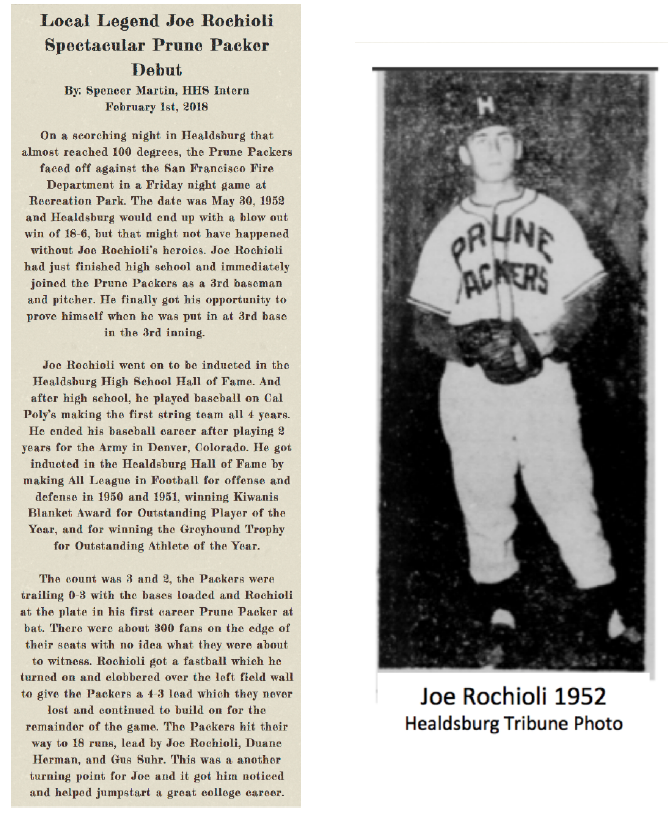 During the summers while attending college, Joe played semipro baseball for the Healdsburg Prune Packers until 1957 when he was drafted into the US Army. Just before he was drafted, he married Ernestine Nicoletti. While stationed at Fitzsimmons Army Medical Center in Colorado he did research on radiated foods and vitamin deficiencies among K rations and also played baseball for the US Army. Upon his discharge in 1959, he was offered a high-paying civilian job at the Medical Center, but his father expected him to return home to work on the family ranch. Instead of the $10,500 annual salary he would have received for the civilian job, his father gave him $1.00 an hour or barely $3,000 a year. He supplemented that income by playing semi-pro baseball for ten years with the Healdsburg Prune Packers until they disbanded. By the time Joe returned to his father’s ranch in 1959, the hops business had declined so significantly that his father had removed all the hops and planted Blue Lake string beans. The hop trellises were simply lowered to accommodate the new crop. The bean crop broke all state records for production and Joe Sr. became one of the most prolific string bean growers in California. The aged grapevines at the ranch had been ripped out in 1957 and in their place French Colombard and Cabernet Sauvignon planted. Later, string beans were interplanted in the vineyard by digging a trellis out and planting the beans on stakes, with two rows of beans between each row of grapevines. The string beans were all pulled out by 1963. Joe considered the quality of the French Colombard superior to any other source in Sonoma County, but the Cabernet Sauvignon failed to ripen. The French Colombard was sold to a few large wine companies, particularly E.&J. Gallo. Joe had taken over the grape growing at the ranch upon his return yet Joe Sr. was still clearly the boss. Some Early Burgundy (Gamay Beaujolais) had been planted at the ranch in 1952 because it was prized for its high yields and usefulness as a blending grape. Joe realized that it was impossible for the Rochioli’s Early Burgundy and French Colombard grapes to compete price wise with the vast plantings of those varietals in California’s Central Valley. In addition, Early Burgundy produced wines more like a rosé, and Joe would have none of that. Joe has remarked, “No way was I going to plant that stuff.” Joe was aware of the quality of French red Burgundy and had a hunch it would do well on the Rochioli property. He knew that the land at the ranch had seven feet of fertile soil over gravel (Yolo sandy loam) making it well-drained and he realized that the climate was compatible. He butted heads with his father and tried to convince him to concentrate on quality French Burgundy varietals, specifically Pinot Noir. Joe believed that the future of grape growing in the Russian River Valley lay in varietal wines rather than bulk wine blends that were the norm at the time. His father was reluctant because the type of wine grapes used for varietally-labelled wines produced small crops making them not as profitable. Joe was persistent and his father finally relented, allowing him to plant Sauvignon Blanc in 1959. Joe traveled to UC Davis where Sauvignon Blanc was planted to multiple clones. He walked the rows and tasted the grapes, finding one row that tasted best. He took all the budwood off that row himself and budded plantings at the Rochioli ranch. Joe was one of the first and most adept field budders. Until the 1970s, all grafting was done by nurseries (so-called “bench graft”). With the widespread demand for vines, “field grafts” became the norm and they required both time and patience. Joe was able to field graft at an extraordinary rate of 500 vines per day and through the years budded practically every vineyard in Sonoma County. For years he traveled the back roads in his 1947 International Harvester pickup truck, with a top speed of 25-miles-per-hour, working tirelessly in other vineyards. Owners simply would not trust anyone else to do their field grafting. The ten acres of Sauvignon Blanc vines Joe planted were so vigorous he had to trellis them on a double- Geneva configuration. For years, the Sauvignon Blanc grapes were sold to Chateau St. Jean and other wineries where it went into white blends. It wasn’t until 1969 that the Windsor Winery bottled Rochioli Sauvignon Blanc as a distinct varietal. The original vines are still producing today but have been supplemented by plantings of 2.8 acres of old vine cuttings in 1985 and of 3.4 acres of clone 376 in 2001. Rochioli Sauvignon Blanc wines have won more awards than any other wine that Rochioli produces. The Sauvignon Blanc vines at UC Davis were eventually pulled out and Joe was never able to obtain more of the same budwood. The clone of Sauvignon Blanc planted originally at Rochioli Vineyard will forever remain a mystery. Some of the old Sauvignon Blanc clone vines planted at Rochioli have been cleaned up by microshoot tip culture at UC Davis allowing virus-free replantings. As soon as Joe Sr. died in 1966, Joe bulldozed the eight acres of French Colombard and Cabernet Sauvignon and set out to plant Pinot Noir. Joe was looking for a red variety that would do well in his cool climate, was attracted to the potential for Pinot Noir, and the farm advisor recommended Pinot Noir as well. Neighbors thought he was crazy at the time. Practically every maker of premium wines in the nearby Napa Valley in the 1960s produced a varietally-labeled and often vintage-dated Pinot Noir, but good examples were rare and often underwhelming due to warm, misplaced vineyard sites and winemaking that was not appropriate for the Pinot Noir paradigm. By the 1970s, with rare exception, California Pinot Noir was deemed unsuitable by many wineries as a stand-alone varietal and those wineries ceased production of Pinot Noir. There was no PInot Noir budwood available locally, so Joe sought out a Frenchman who reluctantly gave him some “suitcase” French Burgundy budwood from the vineyard he farmed south of St. Helena in the Napa Valley. The clonal type and origin of the vine source are unknown but most likely the clone was what is today known as Pommard 4 and possibly included a field selection as well. In 1968, Joe planted 4 acres of East Block Pinot Noir with cuttings from this vine source. The East Block was named for the area east of the telephone pole on the property, one of the earliest, but not the first, plantings of Pinot Noir in the Russian River Valley. The Bacigalupi family had planted Pinot Noir on Westside Road in the Russian River Valley using budwood acquired from the Wente brothers in 1964. Rodney Strong planted the River East Vineyard that included 19 acres of Pinot Noir adjacent his winery in Healdsburg in 1968. Joseph Swan put Pinot Noir in the ground in the Vine Hill region of the Russian River Valley in 1969 with some of the budwood originating from Mount Eden. One caveat, pointed out by Steve Heimoff, in the book A Journey Along the Russian River, is that the Fountaingrove Winery north of Santa Rosa, with operations from 1882 to the 1940s, reportedly planted Pinot Noir in the Russian River Valley in the 1930s at an unknown location and produced a “Sonoma Pinot Noir.” John Haeger, in his book North American Pinot Noir, reported that Fountaingrove bottled a Pinot Noir that was 100% varietal no later than 1936. The label below is from the 1940s.
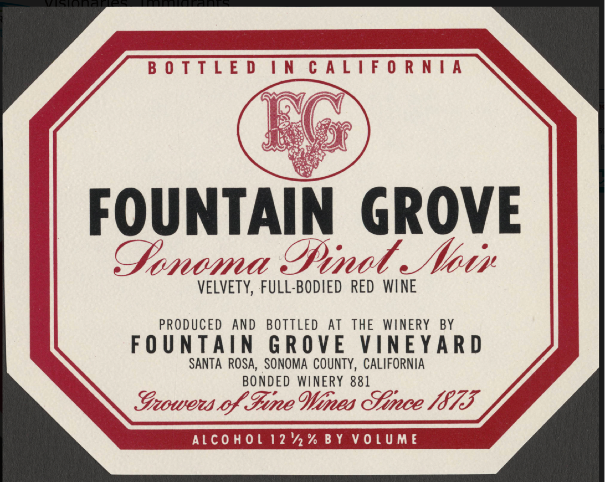 In 1969, Joe acquired the shares owned by his brother and sister and became the sole proprietor of Rochioli estate. The following year, 4 acres of West Block Pinot Noir were planted using budwood from either Karl Wente’s estate vineyard in Livermore (presumably French clones) or from Wente’s UCD-certified plants in the Arroyo Seco region of Monterey County (most likely a clone or field selection of Pommard 4). The exact clonal pedigree of West Block plantings remains a mystery as vine morphology has not been confirmatory but it is often concluded that the vines are Pommard. The initial Pinot Noir plantings at the Rochioli property were typical for the time with a 14-foot spacing between the rows and 8-feet spacing between the vines (see photos below of original West Block vines). The rootstock was non-phylloxera-resistant AxR1.
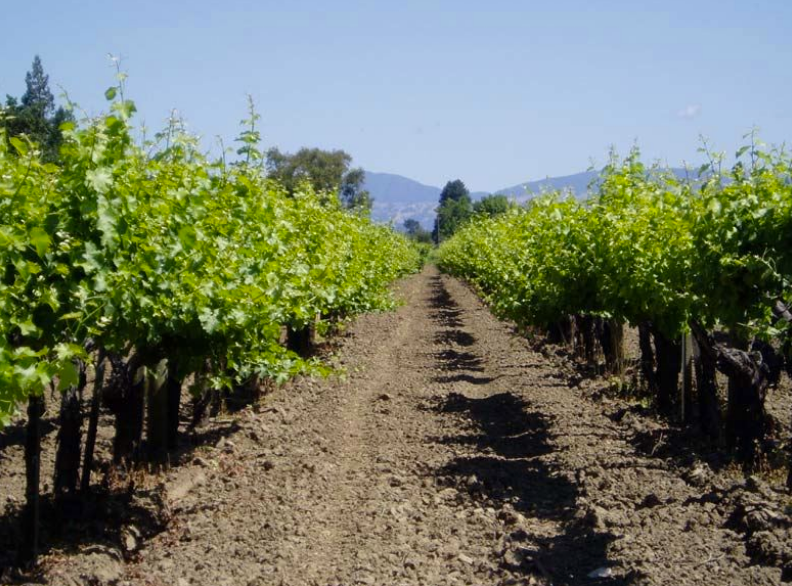
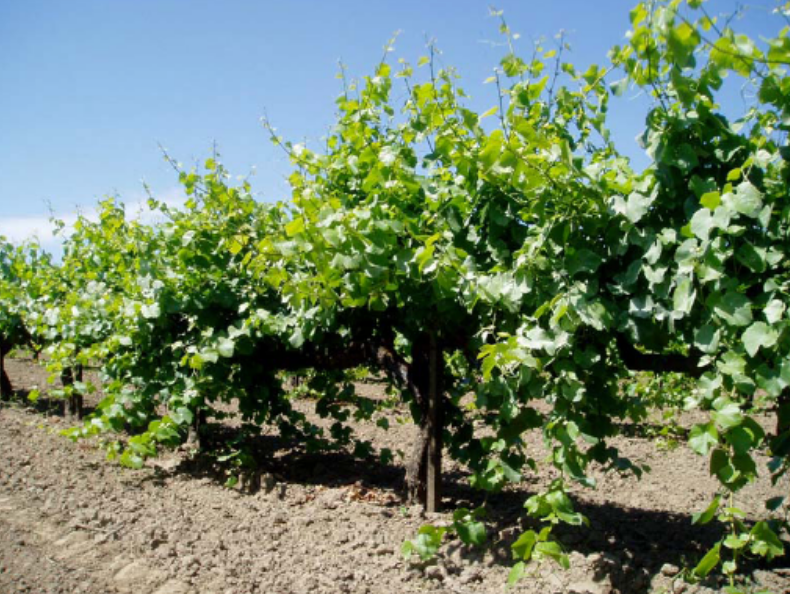 The West Block Pinot Noir is often referred to as the “mother block” because cuttings from this block were used for subsequent block plantings on the Rochioli ranch as well as many other vineyards in the Russian River Valley including Allen Vineyard located across Westside Road from Rochioli vineyards. The original plantings are referred to as Old Vine West Block. Currently, the West Block is about one-third of its original size but newer plantings at West Block in 2008 added 2.5 acres of West Block selection. The original West Block currently produces very little fruit but it has always been Joe’s favorite. The first 3.5 acres of Chardonnay vines were planted on the Rochioli ranch in 1972 (clone 04 and 108 - a combination of FPS selections 04 and 05) where the Little Hill Block currently resides. This acreage was part of the wave of Chardonnay plantings in California in the early 1970s that reached a total of more than 7000 bearing and nonbearing acres by 1975. Several blocks of additional Pinot Noir and Chardonnay were planted by Joe over the years. The virus-afflicted, original vines at East Block were pulled out (last vintage 2008) and replaced with Pommard clone in 2010. Many Rochioli wine enthusiasts begged Joe not to pull out the East Block vines, but at production levels of less than one ton per acre, it simply did not make economic sense to preserve them. Over the years there have been many challenges. The fog is a major factor in the successful growth of vines in the Russian River Valley because it keeps the grapes cool in the evenings allowing for retention of natural acidity. With that frequent fog, however, comes the threat of mildew. Joe says he has had to constantly monitor mildew pressure and often has to spray for mildew every 10 to 14 days. The proximity of the vineyards to the Russian River created vulnerability to voracious pests including bluegreen sharpshooter and mealybug. More recently, a few vines in the Sweetwater Vineyard have tested positive for grapevine red blotch disease (GRBD), a viral disease that leads to fruit ripening issues. These vines were removed and replanted. Rigorous testing at Rochioli has found “clean” vines that are reserved for new plantings. Here is a summary to date of Pinot Noir planting acreage that makes up the majority of the 140 planted acres at Rochioli Vineyards:
Three Corner Vineyard This 3.7-acre vineyard, located north of Rochioli Vineyard across Westside Road was initially planted in 1974 by Joe using West Block bud material with later plantings also containing West Block selection and Pommard 4 and Dijon 115 clones. Three Corner Vineyard was originally part of the Allen Vineyard but was deeded to Joe by Howard Allen as a favor for farming the Allen Ranch for many years and is one of the Rochioli estate vineyards. Total: 3.7 acres. Little Hill Vineyard This vineyard lies adjacent West Block. 2.2 acres were originally planted in 1985 from West Block cuttings. 1.8 acres of West Block selection and 1 acre of RC selection was added in 1994, 2.4 acres of West Block selection and 2.3 acres of Pommard clone were added in 2005, and 1 acre of West Block selection and 5 acres of Pommard clone were planted in 2014. Total: 15.7 acres.. River Block Vineyard 13 acres of West Block selection were planted in 1988. 4.5 acres of clone 115, 4.5 acres of clone 777 and 4.7 acres of Pommard clone were added in 2000. Total: 26.7 acres. Big Hill Vineyard. A rocky hillside site first harvested in 2011 and initially offered as a vineyard-designate Pinot Noir with the 2016 vintage. The Rochiolis consider this vineyard the “Grand Cru” of the entire estate because of the ideal red gravelly loam soil and the southern exposure. The Pinot Noir wines have more structure than those from other blocks and offer more complexity and interest, that is, a little less fruit emphasis and more “Burgundian” in character than typical Russian River Valley Pinot Noir. Big Hill Vineyard wines have garnered the highest scores among all Rochioli Pinot Noirs. 3.8 acres of West Block selection and 0.8 acres of Calera selection planted in 2009. Total: 4.6 acres.Noirs. Sweetwater Vineyard 2.9 acres of clone 115 planted in 1994, 3.6 acres of clone 777 planted in 1999, 4.7 acres of West Block selection added in 2000 and 2017,1.5 acres of Pommard clone planted in 2014, and 1.6 acres of Calera selection in 2017. Total: 14.3 acres.
Summary of additional plantings: 30 acres of Chardonnay (Mt Eden selection, Wente selection, Hanzell selection, Clone 4 and 108, Dijon 5, 76 and 95) is planted in River Block, Little Hill Block, Sweetwater Vineyard and what is known as the Mid-40 Block. 7.2 acres of Sauvignon Blanc is planted in the Little Hill Block and Mid-40 Block. There are tiny plantings of Syrah, Cabernet Sauvignon and Valdiguié. A map of the entire Rochioli Vineyard is displayed below and can be accessed on the Rochioli website for easier readability.
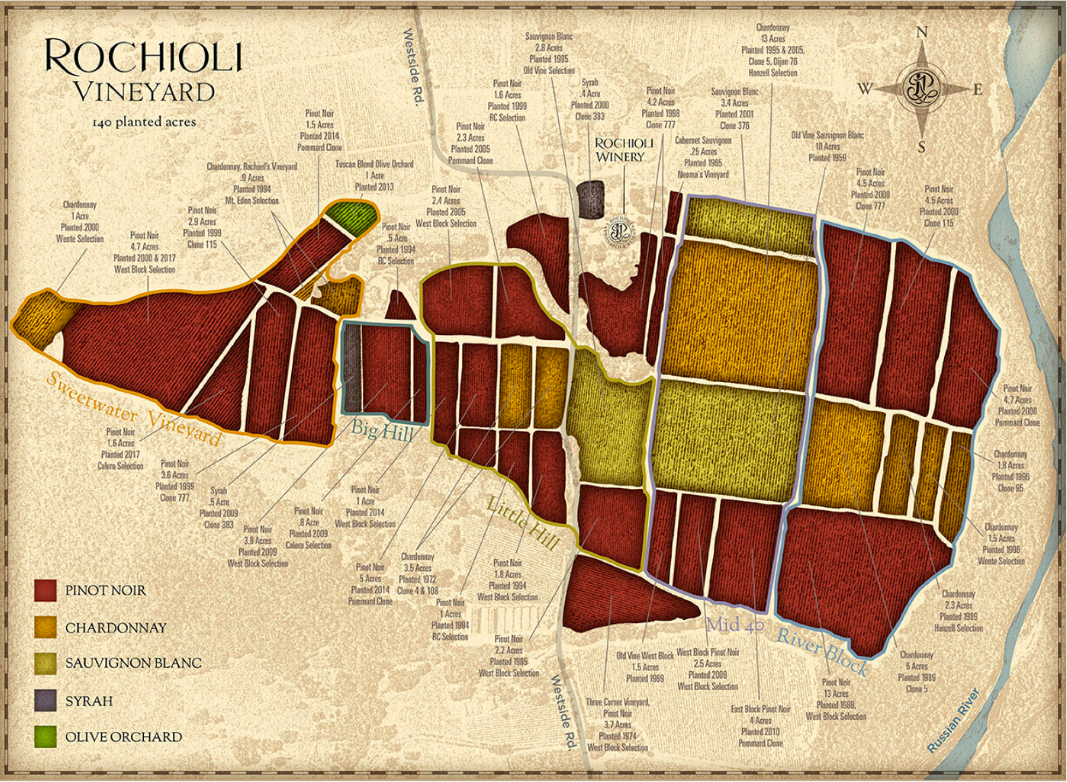 The first viable Pinot Noir crop from the original plantings was in 1971 and the grapes were sent to a cooperative crush facility owned by E.&J. Gallo in Windsor. Most of the grapes from Russian River Valley winegrowers went into what Joe has called “Gallo garbage.” There were simply few buyers for the grapes. Joe recalls how sick he became when he had to send his beautiful Pinot Noir grapes from East Block and West Block to Gallo, who then proceeded to blend them with other grape varieties from the Sonoma, Napa and Central valleys to make his highly successful Hearty Burgundy Hearty Burgundy was first released in 1964 in 1.5 liter “jugs” and was non-vintage dated. I have fond memories of Hearty Burgundy for it was my father’s favorite wine. It graced our family dinner table on many occasions, and was a frequent accompaniment to pizza when we dined at his favorite neighborhood Italian restaurant. The exact composition was a trade secret, but it was believed to be a blend of Zinfandel, Tempranillo, Syrah, Petit Verdot, Grenache, Petite Sirah, Cabernet Sauvignon and briefly, Joe’s Pinot Noir. Winemaker Stephen Russell, a UC Davis enology graduate who went to work at Gallo in 1960, recalls, “The mixture of almost any grape available at the time was challenging to produce because the goal was to make Hearty Burgundy taste consistently the same, although the types and sources of grapes varied widely with each vintage.” In Ellen Hawkes book, Blood & Wine, The Unauthorized Story of the Gallo Wine Empire, she states, “Hearty Burgundy was praised by some critics for its depth and complexity, and even gained popularity among ‘wine snobs’ who usually scorned the Gallo label.” Hearty Burgundy graced the cover of Time magazine in 1972, an issue devoted to the booming California wine industry. They weren’t kidding when the magazine cover claimed, “There’s Gold in Them Thar Grapes,” because Joe prized fruit was in the blend. In 2014, a commemorative bottling was offered for $9 celebrating the wine’s 50th anniversary.
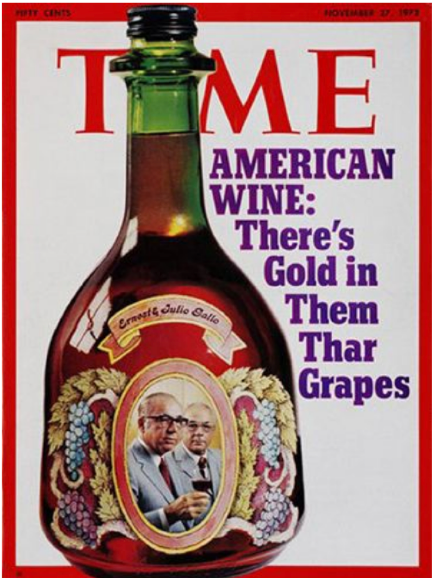 In the 1960s, grape farmers in Northern California were not organized and were being victimized by Gallo and a few other large wineries who controlled prices that were determined after the receipt of grapes, so-called open-price contracts. The growers would deliver their grapes to Gallo in September without knowing what they would be paid. In December of the vintage year, before property taxes were due, the farmer would receive a check in the mail from Gallo that amounted to whatever Gallo wanted to pay. In 1963, Joe helped form the North Coast Growers Association (NCGGA) to give small wine grape growers a voice in dealing with the large company buyers. After a considerable amount of effort spread over several years, the NCGGA lobbied in Sacramento and the state eventually passed legislation that eliminated open-price contracts. An upfront agreement on the price wineries would pay the winegrowers for their grapes became the law. The NCGGA forced Gallo to commit to paying $100 a ton with a $5 a ton bonus if the grapes were really premium. Joe had acquired some contracts for his grapes including Dry Creek Winery and Chateau St. Jean who bought his Sauvignon Blanc grapes. He was selling his Pinot Noir to Korbel for their sparkling wines and to Wente and Gallo for their blended wines. As he looked for someone to produce a varietal Pinot Noir from his grapes, good fortune was to arrive in the form of a fledgling winery a few miles away on Westside Road. In 1972, Davis Bynum, a San Francisco newspaper journalist, home winemaker, and the son of noted California wine writer, Lindley Bynum, bought the 84-acre River Bend Ranch on Westside Road for a reported $115,000. The property had a hop kiln used for drying hops and Bynum converted the hops processing room next to the kiln into a winery and launched Davis Bynum Winery. Bynum developed several handshake agreements with local winegrowers to acquire grapes include Joe, Howard Allen and Rick Moshin but he was particularly enamored with Rochioli fruit. He bought Rochioli’s Pinot Noir in 1973 and from 1973 to 1979 (? 1981) was the only winery receiving Rochioli fruit. Bynum recalled in an 2013 interview that in 1973 Rochioli was getting $150 a ton for Pinot Noir. He offered $350 (also reported to be $450) to make a varietal wine and got all of Rochioli’s Pinot Noir that vintage. Bynum’s son Hampton and consultant Robert Stemmler, a pioneering Pinot Noir winemaker in Sonoma County, crafted the wine at Davis’ winery. Davis Bynum, who passed away in 2017, is shown in the photo below.
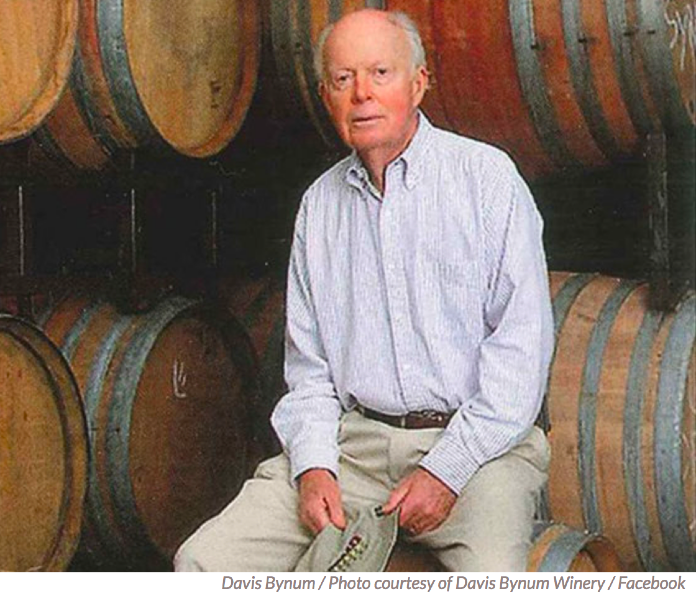 The 1973 Davis Bynum Winery Rochioli Vineyard Russian River Pinot Noir and the 1973 Joseph Swan Russian River Pinot Noir were probably the first Pinot Noirs to carry the words “Russian River” on the label, ten years before the Russian River Valley AVA was approved. Bynum’s 1973 wine was the first Russian River Valley vineyard-designated Pinot Noir. The label read, “From the vineyard of Joseph Rochioli Jr. on Westside Road in the Russian River” Despite the historical significance of the 1973 Pinot Noir, Joe claims the 1978 Davis Bynum Rochioli Vineyard Russian River Valley Pinot Noir is the best Pinot Noir he has ever tasted. Beginning in 1976, Joe had Davis Bynum produce 1,000 cases of Pinot Noir. He then joined with two partner investors to increase production at Davis Bynum Winery to 2,000-3,000 cases of Pinot Noir and Chardonnay. The wines were bottled under the Fenton Acres label, referencing the original name of the Rochioli property. The label stated, “Sonoma County Pinot Noir” with “From the Vineyards of Joe Rochioli” in fine print on the bottom. The wines proved to be a tough sale, the partners soon lost interest in the venture, and the partnership was dissolved.
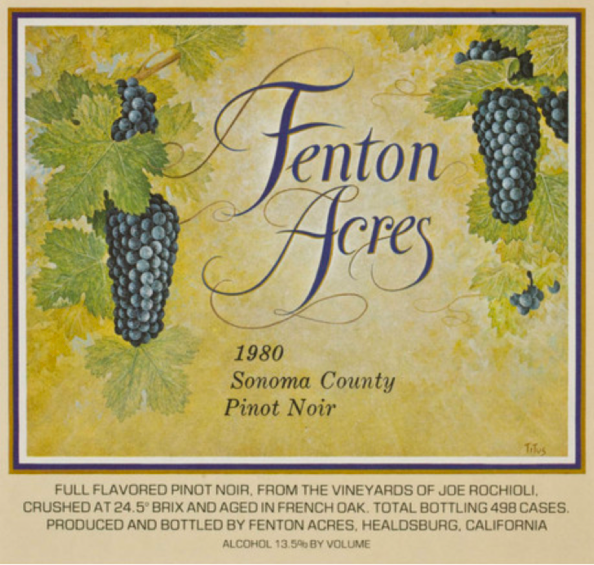 Gary Farrell, who vinified the Fenton Acres wines as a winemaker at Davis Bynum Winery, would play a vital role in validating the Russian River Valley as an exceptional region for domestic Pinot Noir and in assisting the Rochiolis in establishing their own winery. Farrell had majored in political science at Sonoma State University but became interested in wine as a student and decided after to college to become a winemaker. He was largely self-taught, but he added valuable skills during the mid-1970s, working in the cellars of Tom Dehlinger, Robert Stemmler and Davis Bynum. He developed a special friendship with Davis Bynum’s son, Hampton, and was hired as winemaker at Davis Bynum Winery in 1978, continuing there until 2000. Farrell started his own label in 1982, releasing a 50-case blend of Rochioli West Block and North Hill of Allen Vineyard fruit. Farrell has said, “It (Rochioli Vineyard) confirmed my opinion that world-class Pinot Noir could be grown in the Russian River Valley.” The wine sold for a modest $80 a case because there was little demand for Russian River Valley Pinot Noir at the time and he had to hand-deliver the wine to local retailers and customers. Farrell’s wines soon took on considerable praise and won many awards. I remember fondly drinking many Gary Farrell Russian River Valley Pinot Noirs from the 1980s. Joe’s son, Tom, was most instrumental in establishing the J. Rochioli Vineyards & Winery wine brand. He had become disenchanted with his job in corporate banking at Bank of America in Santa Rosa leading him to ask his father if he could work on the Rochioli ranch. He suggested that the name Rochioli should be the wine brand rather than Fenton Acres to signify a family operation. Tom put together a business model for a 10,000 case winery and he was taken in as a partner and winemaker. Every aspect of the winery business going forward was Tom's creation. The photo below shows father and son, what I call “No ordinary Joe” and “No typical Tom”.
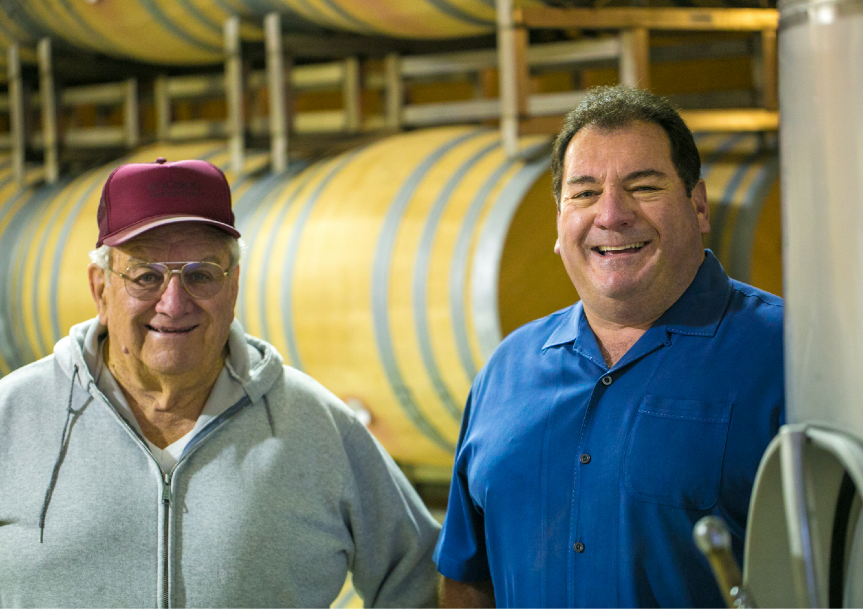 Tom had no formal training in winemaking so Farrell was asked to make 150 cases of the inaugural 1982 J. Rochioli Vineyards & Winery Rochioli Vineyard Pinot Noir, trading winemaking for grapes he used for his own 1982 inaugural release. That now historic 1982 J. Rochioli Vineyards & Winery Russian River Valley Pinot Noir label is shown below.
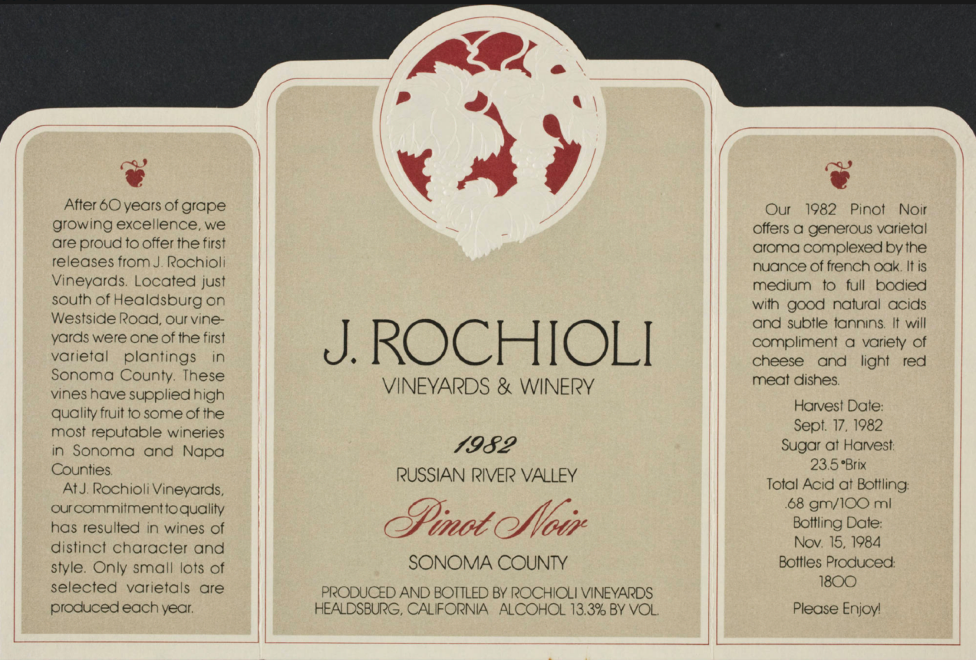 Tom learned quickly from Farrell but he also had an intuitive sense about how Rochioli fruit should be handled. Using Tom’s business acumen and winery design input from Gary Farrell, a winery was constructed on the Rochioli estate in time for the first crush at Rochioli in 1985. In 1987, the Wine Spectator named the 1985 J. Rochioli Vineyards & Winery first estate Pinot Noir crafted primarily by Tom at the new winery as the “Best Pinot Noir in America.” Tom has remained the winemaker at Rochioli since 1986. The winery was remodeled with specific rooms for red and white wine production and was finished in 2009.
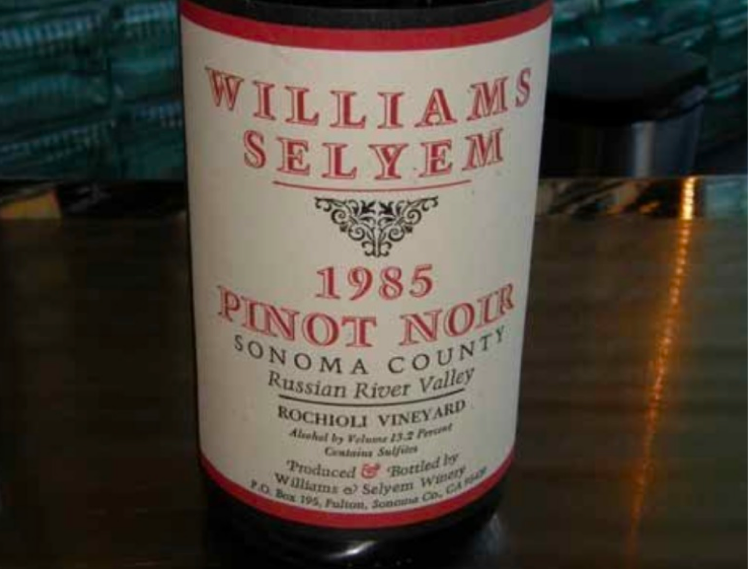 Burt Williams of Williams Selyem Winery was an additional inspirational winemaking influence on Tom and it was Williams Selyem that made Rochioli Vineyard famous, In 1987, the 1985 vintage Williams Selyem Rochioli Vineyard Russian River Valley Pinot Noir, vinified at a 900-square-foot two-car garage in the tiny Russian River Valley town of Fulton, won a Double Gold Medal and the Sweepstakes Award at the California State Fair Competition and became the most seminal wine in the history of California Pinot Noir. The wine was voted the best of 2,316 wines submitted by 416 wineries. As the first vineyard-designated Pinot Noir produced at Williams Selyem, this wine was sourced from the original West Block plantings but this was not evident on the label. 295 cases of this wine were produced and it sold for $16 a bottle. Williams Selyem was also voted “Winery of the Year.” When Burt reminisced about this award, he would nearly tear-up, saying, “Here was this little winery in a garage competing against over 400 wineries in the wine competition, many of which were quite large. When we released our 1985 Pinot Noir, we knew we were doing something right.” In 1987, Becky Wasserman a well-known Burgundy exporter, along with Burgundy vignerons, visited Williams Selyem and asked for 50 cases of the 1985 Rochioli Vineyard Pinot Noir! She only received 1 case but did get 25 cases of the 1986 vintage of the same wine and it began showing up on wine lists in Burgundy. An article appeared in the June 27, 1987, business section of the Santa Rosa Press Democrat announcing the top prize won by Williams Selyem (copied below). Note the incorrect name of the winery in the article, for the two names were never hyphenated. Williams Selyem continued to source West Block fruit until the winery was sold in 1997 after which time Williams Selyem has received old and new plantings from the River Block.
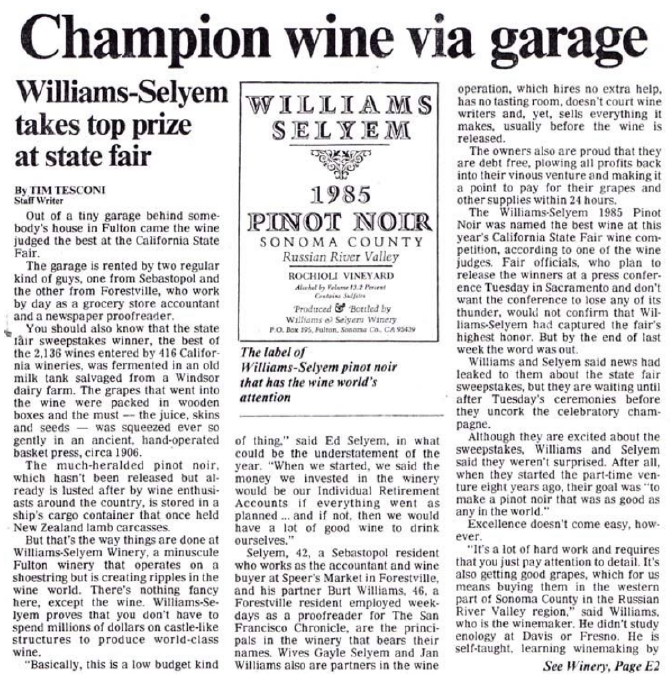 The demand for Rochioli fruit soon took off and Joe was able to demand premium prices for his grapes. He continued to mainly sell fruit to Williams Selyem and Gary Farrell at Gary Farrell Vineyards & Winery and his second venture Alysian Wines, and for years these two wineries were the only ones permitted to put “Rochioli Vineyard” on their label. Today, the permission has been extended to Miura, Ramey Wine Cellars and to Terry Bering for his Castalia label. Terry has been the cellar master at J. Rochioli Vineyards & Winery since 1990 (and the only full-time employee outside of Tom in the cellar), and in 2019 Terry released his 2017 Pinot Noir sourced from Rochioli fruit, marking his 25th-anniversary producing Rochioli Vineyard Pinot Noir. I have reviewed the excellent Castalia Pinot Noir wines in the PinotFile going back to 2000.
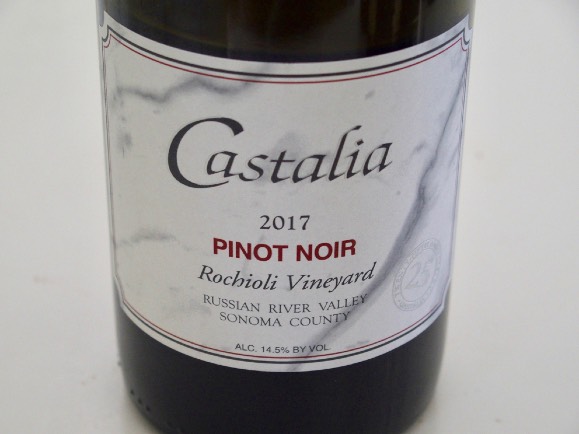 Rochioli Chardonnay is currently sold to Williams Selyem, Gary Farrell Vineyards & Winery and Ramey Wine Cellars. A plump cluster of Rochioli Chardonnay is shown in the photo below. A number of other wineries have sourced Rochioli fruit through the years but there are many other notable small prestigious producers of Pinot Noir in California who have begged for fruit but had to resort to joining a long waiting list. Joe has told inquiring wineries they will never get any grapes, but they insist on putting their name on the waiting list anyway. Cuttings from Rochioli vines are no longer sold or given away. A beautiful cluster of West Block Pinot Noir is shown below in a photo.
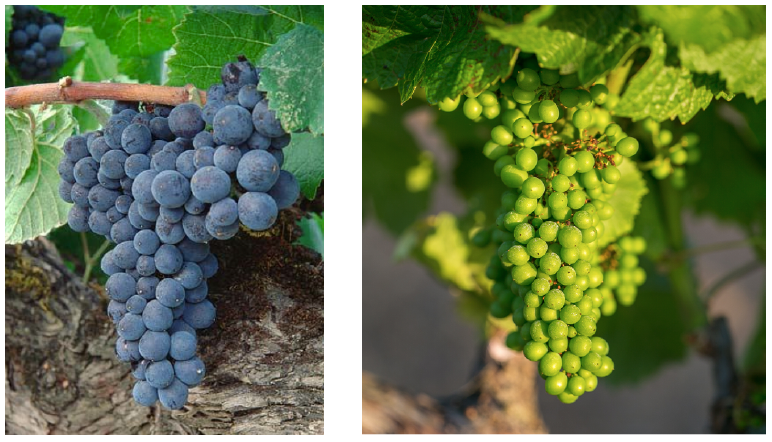 The Estate blends of Pinot Noir, Chardonnay and Sauvignon Blanc are bottled under the Rochioli name, while the single-block vineyard-designated Pinot Noirs and designated Chardonnays are labeled as J. Rochioli Vineyards & Winery. The classy labels have remained essentially the same through the years. Beginning with the 2018 vintage, the back label of the “Estate” wines will state “Single Vineyard Blend” to more accurately.
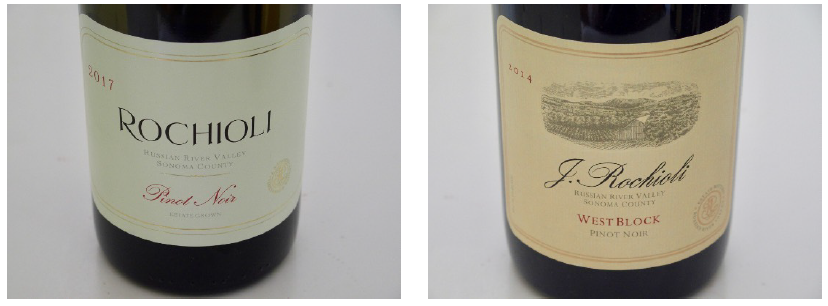 An Estate Pinot Noir has been produced every year since 1982. It is a blend of grapes from all of the single block vineyards except Three Corner. A Reserve Pinot Noir, consisting of a selection of barrels from the West Block was produced in 1986, 1988, 1990 and 1991. In 1988, it was labeled as Special Select. In 1992, the first of the block designates debuted with the West Block and Three Corner Block Pinot Noirs. East Block was released separately in 1993, 1994, and then yearly from 1997 to 2008. Little Hill Block and River Block debuted in 1999 and the Sweetwater Vineyard Pinot Noir was first offered in 2007. The five original single-block Pinot Noirs - East Block, West Block, Three Corner, Little Hill and River Block - were first offered together in 1999. Tom had visited Burgundy (Joe never did) in 1990 and was struck by the differences in the wines from the seven climats at Domaine Romanée-Conti (DRC). Tom has said, “Here are these blocks of vines together in a small area on a slope that looks fairly uniform, yet the wine from each plot is unique and different.” Both the quality and the distinctness of the DRC wines led to his epiphany. Tom had noted differences in barrels from different blocks on the Rochioli estate despite a majority of the vine material originated from West Block cuttings, cultivation was identical throughout the five blocks, and the vinification was the same for each plot. Each wine was recognizably distinct, reflecting differences in terroir similar to the subtle disparities in soil and microclimate that define the distinct terroirs at DRC and those of Burgundy’s Côte d’Or. The specifics of the inaugural release of all five 1999 J. Rochioli Block Pinot Noirs: East Block - 1.2 tons per acre, 150 cases, $85; West Block - 1.6 tons per acre, 400 cases, $65; River Block - 150 cases, $55; Three Corner - 100 cases, $55; Little Hill - 200 cases, $50. Production has varied since 1999 because some of the old vines have been replaced periodically, older plantings have had lower yields as newer plantings have come online, and in some vintages, not every block designate was bottled. The current target is 12,000 cases annually and this has been relatively consistent in recent years. The single-vineyard Pinot Noir and Chardonnay wines account for about 3,000 to 4,000 cases with the remainder made up of Estate (Single Vineyard Blend) Pinot Noir, Chardonnay and Sauvignon Blanc. Tom says, “We are not trying to get bigger, just better!”About 50% (180 tons) of grapes harvested at Rochioli each year are sold to other wineries. Farming such a large estate is daunting. A crew of men who have worked on the property for many years have provided familiarity with the vines. The crop is thinned as many as five times during the growing season beginning with suckering in early spring and the removal of green grapes during veraison. Joe was one of the first winegrowers to drop leaves on the sunny (west) side of the vines and this process is widely practiced in California vineyards to this day. The ongoing replacement of old vines entails additional labor. Tom has directed most of the new planting over the past 20 years in addition to his duties as winemaker and business manager. More recently, as part of a continuing preservation process, the winery has begun to use the techniques of Simonit & Sirch, wine master pruners for many famous vineyards in Burgundy. The Rochioli staff has been trained to properly prune vines to insure restoration and preservation of the historic vines that will allow them to live a long life, potentially up to 50 years. Joe was a tireless and devoted farmer who would arise at 4:00 A.M. and work 10 hours a day, 6 days a week. He has told me, “I was never in it to make a lot of money, I did it for pride. When somebody asks how we do it, I answer that it’s the combination of soil, climate, clones, instinct and farming practices.” He spurned vacations and rarely left his property. Joe performed most all of the equipment repair required on his farm including welding. He built many of his own implements, rebuilt engines, restored plows and cultivators, and designed farming tools like cane cutters. Remarkably, he even built his own house over the course of three years using a $15,000 loan from a wealthy Santa Rosa businessman (his son Tom now resides in the house located on the Rochioli property). Despite Joe’s devotion to his vineyard, he did find time to give back to the community. He served sixteen years on the Westside Union Elementary School Board and twenty-five years on the Healdsburg Future Farmers Fair Board of Directors. He was one of the founding members of the Healdsburg Fair, dedicating decades to support youth in agriculture. He has also been a member of the California Farm Bureau for over fifty years. Joe has received numerous accolades and awards over the years. In October 2009, he received the Lifetime Contributor to Sonoma County Agriculture Award, and in October 2017, he was given the “Methuselah Award” for his lifetime contributions to Sonoma County’s wine industry. Tom has also been honored by the wine establishment. As part of the 2016 Sonoma County Barrel Auction, Tom was one of four icons, along with Helen Bacigalupi, Tom Klein and David Rafanelli, honored for their role in shaping the heritage and history of Sonoma County wine. The four icons are pictured below with Tom in the center.
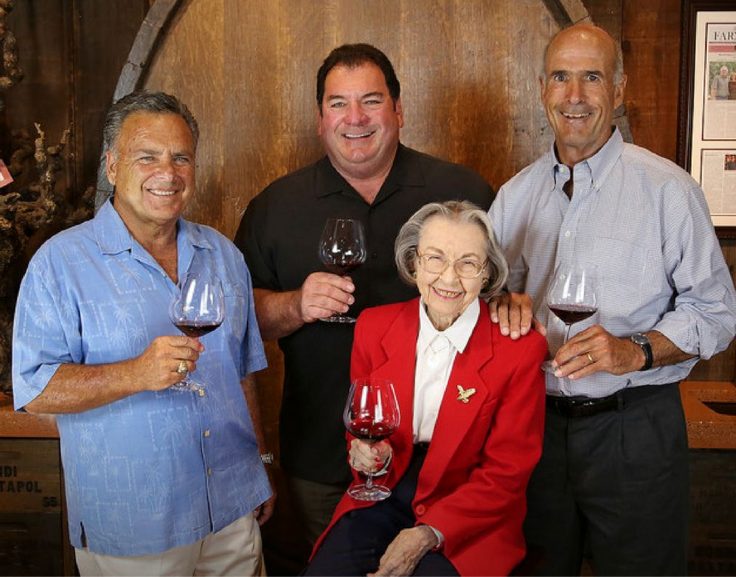 The years of hard work have taken a toll on Joe, but after many surgeries, at age 86, he still acts in a supervisory capacity overseeing the vineyards. Joe was divorced in 1969 and married Vivienne Sioli, the girl he adored in high school (the couple are pictured below). Joe had two previous children, she had three, and between them, they have eleven grandchildren. Joe, in the Italian tradition, hosts frequent family dinners on the weekends with nearly forty family members in attendance.
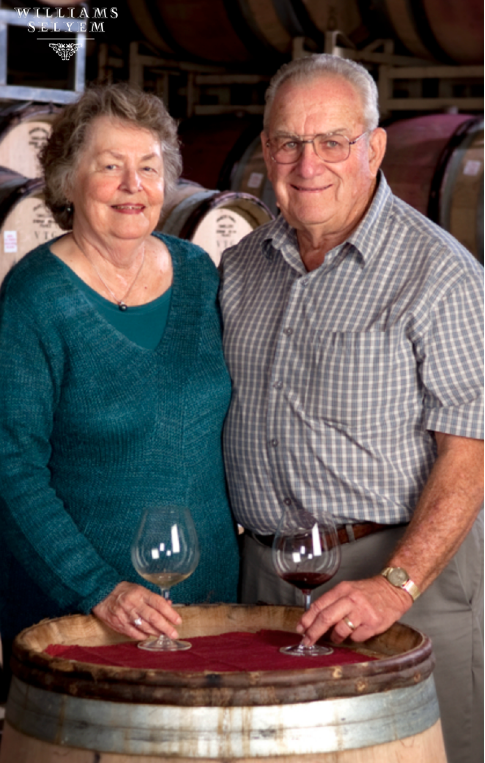 Joe has preserved much of his history including his father’s horse saddles and horse carriage, a restored Model T truck, and his prized, restored 1941 Chevrolet that he drove in college, all housed in a 60’ x 60’ barn.
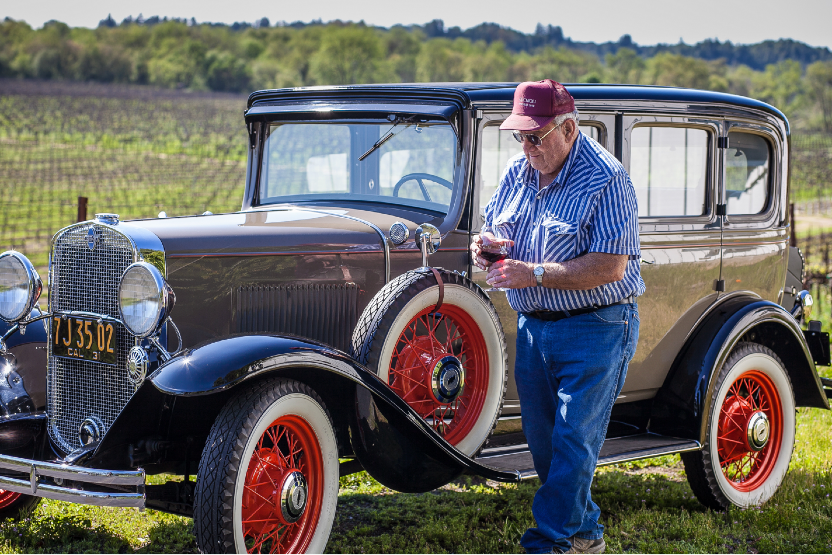 Joe is no ordinary Joe and his superb wines reflect his years of devotion to the craft of winegrowing. I have never met anyone like him and after reading this lengthy history, I don’t think the reader will ever discover another winegrower with such a remarkable story to tell. Joe’s history is best summarized in his own words. “My father taught me the ethic of hard work - you work hard to eat and put a roof over your head. I used to dream about living to be 65 and being a millionaire. I’ve ended up with a great winery and good friends, and I am proud of what I’ve accomplished as a shy, little Italian boy who spoke no English.”
References:
Wines of J. Rochioli Vineyards & Winery
The winery and tasting room is located at 6192 Westside Road in Healdsburg. Tasting is available by appointment only even for mailing list members (see the winery’s website at www.rochioliwinery.com/Visit or email appointments@rochioliwinery.com). The fee for non-members of the mailing list is $25. Of course, tasting is not currently available due to the coronavirus pandemic. The Single Vineyard Blend Estate Pinot Noir, Estate Chardonnay and Estate Sauvignon Blanc as well as the Estate Blanc de Noir sparkling wine are frequently available for purchase at the time of the tasting.
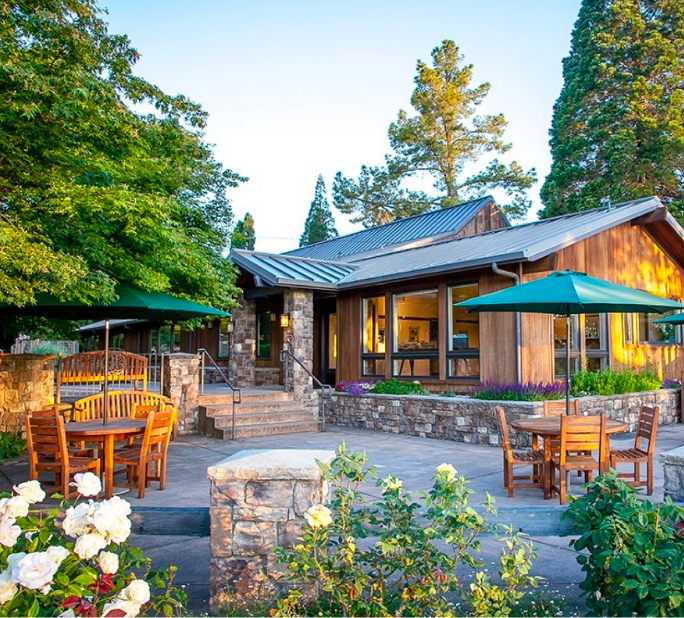 The vinification of Rochioli Pinot Noir involves primarily whole berry fermentation with proprietary yeast in stainless steel open-top tanks. Up to 20% whole cluster may be included depending on the vintage, vineyard and ripeness of the stems. Tom says the inclusion of stems adds a “spice cabinet” to the finished wines. Hand punch downs of the cap are employed. The wines are pressed at dryness and sent to barrel without extended maceration, and aging takes place in 90% Francois Fréres 3 to 4-year air-dried French oak barrels. The percentage of new oak will vary with the wine but is often 30% for the Estate wines and 40-50% for the single block wines. The West Block Pinot Noir is always aged in 100% new oak. Aging extends from September of the vintage year to the following November (14-15 months), a little less for the Estate Pinot Noir. The wines are held in bottle to the early part of the subsequent year in the case of the Estate wines and the latter part of the subsequent year for the block-designated Pinot Noir wines. Tinkering with the vinification is an ongoing process including experimenting with different oak sources. The Chardonnays are gently whole-cluster pressed, fermented with proprietary yeast, undergo full malolactic fermentation and are aged sur lies. The finished wines are racked just prior to bottling and are unfiltered. The Rochioli Pinot Noirs have a consistent style of ripe, rich fruit that is aromatic, succulent and spicy and tastes damned good. Many have raved about the Pinot Noir wines in the wine press, calling them “A liquid portrait of the Russian River Valley.” Others have pointed out, “The Pinot Noir wines have a consistent style of ripe, rich and succulent fruit but are never too big or oaky, remaining pure and fresh.” Age ability is dependable, but Joe has never seen two vintages the same in all the years he was worked the Rochioli estate. He feels that the age-ability of his wines reflects the vintage with some years aging gracefully for well over ten years and some years peaking earlier. Tom tells his consumers that the vineyard-designated Pinot Noirs perform best usually between six and ten years after the vintage. After that, it is every man for himself. I recently opened a 2003 J. Rochioli Vineyards & Winery Little Hill Russian River Valley Pinot Noir. It was terrific upon opening but faded markedly a few hours later. If you do open a similarly aged Rochioli Pinot Noir, drink up in the first hours after opening. J. Rochioli Vineyards & Winery keeps a low profile from a marketing standpoint since they don’t have to publicize scores or the adoring comments from wine writers. They sell all the wine produce and probably could sell twice that amount. This relieves the winery of the expenses of promotion and allows them to concentrate on farming and wine production. The winery and vineyards are in a very enviable position in the current competitive Pinot Noir marketplace as a result of many years of devoted farming and superb winemaking. Tom’s daughter, Rachael, is now the winery’s Sales and Marketing Associate. Tom’s son, Brian, is a UC Davis graduate specializing in beer brewing and is also employed outside the winery in wine sales. Tom is encouraging him to join the winery at a future date.
The 2018 and 2019 vintage Estate wines were released in January 2020. The back label now contains the words “Single Vineyard Blend” to indicate that the Estate wines are sourced from single vineyards at Rochioli.
2019 Sauvignon Blanc 14.5% alc., 2950 cases, $34. 64% from original Sauvignon Blanc plantings dating to 1959, 21% is from the newest 2011 planting of the rare clone 376 and 14% is from the hillside planting dating to 1985. Tank fermented at a cool temperature. 2018 Estate Chardonnay 14.5% alc., 1724 cases, $58. A blend of the top Estate vineyards. Average vine age is 23 years. 52% Mid-40, 36% River Block, and 12% Little Hill. Whole cluster pressed to barrel with no skin contact. 100% MLF. 2018 Estate Pinot Noir 14.5% alc., 2926 cases, $64. A blend of several single-vineyard sites. Average vine age is 18 years. 40% Sweetwater, 39% Little Hill, 12% Big Hill, 6% West Block and 3% East Block. Fermented in open-top stainless steel tanks, hand punch downs. Aged in French oak barrels for 15 months.
 The 2018 Single Vineyard Chardonnays and 2019 Old Vine Sauvignon Blanc were released in March 2020.
2018 River Block Chardonnay 200 cases, $68. Old Wente field selection planted in 1989. Average yield was 2.6 tons per acre. Bottled unfiltered. 2018 Sweetwater Chardonnay 150 cases, $72. Wente selection planted in 2000. Bottled unfiltered. 2018 Little Hill Chardonnay 150 cases, $72. Oldest Chardonnay planted to clones 4 and 108 in 1972. Bottled unfiltered. 2018 Rachael’s Vineyard Chardonnay 125 cases, $78. Mt. Eden field selection planted in 1994 and 1999. Bottled unfiltered. 2019 Old Vine Sauvignon Blanc 120 cases, $48. Planted in 1959, it is one of the oldest known Sauvignon Blanc vineyards in California. Yield is only 2.4 tons per acre.
The 2018 Single Vineyard Pinot Noirs will be released in August 2020. Here is the lineup of the 2017 vintage Pinot Noirs released in August 2019.
2017 Sweetwater Pinot Noir $86. 2017 Little Hill Pinot Noir $86 2017 River Block Pinot Noir $90. 2017 Big Hill Pinot Noir $90 2017 Three Corner Pinot Noir $90 2017 West Block Pinot Noir $112.
The Estate Rosé of Pinot Noir is released each April. Estate Syrah and Estate Valdiguié are released each September. A 100% Pinot Noir Blanc de Noir was produced in 2011, 2014 and 2016 and is sometimes available. Magnums are bottled every vintage but these are reserved for family, special tastings and charity donations. Accolades are reported on the website for Antonio Galloni (Vinous), Jeb Dunnick and Robert Parker’s Wine Advocate. For the 2016 and 2017 vintages, scores ranged from 93 to 97+ for the single-vineyard Pinot Noirs. Visit the website at www.rochioliwinery.com to view the accolades for Rochioli Pinot Noir, Chardonnay and Sauvignon Blanc over the past 7 vintages.
Recent Reviews of Rochioli Vineyard Pinot Noirs
2017 Rochioli Estate Russian River Valley Pinot Noir 14.5% alc., $64. Sourced from Sweetwater (38%), West Block (22%), Little Hill (18%), East Block (12%), Big Hill (8%) and Three Corner (2%). 10% whole cluster. Aged 15 months in French oak barrels. · Moderate garnet color in the glass. The nose is amazingly expressive upon opening, revealing deep and penetrating aromas of fresh red and black Bing cherry and baking spices. Mid weight plus in style, entering with a charge of black cherry and black raspberry fruits underlain with tastes of cardamom spice and cola. Creamy in texture, with an incredibly long finish that lasts for what seems like a minute. More approachable than the Block Designate wines. Score: 93
2014 J. Rochioli Vineyards & Winery West Block Russian River Valley Pinot Noir 14.5% alc., 228 cases, $110. Yield 1.3 tons per acre. · Moderately dark garnet color in the glass. The nose unravels slowly to reveal aromas of black cherry and Asian spices. Full-bodied in a richly endowed style, with a core of black cherry, blackberry and cola flavors. Plush on the palate with enough acidity to cut the richness. Impressive harmony, with an extremely long and generous finish. Much more giving, even transcendent, when tasted the following day from a previously opened and re-corked bottle. Score: 97
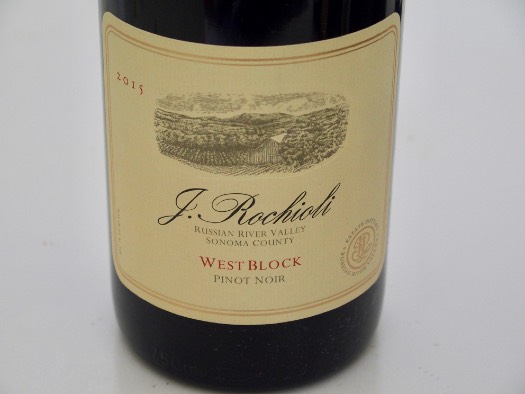 2015 J. Rochioli Vineyards & Winery West Block Russian River Valley Pinot Noir 14.5% alc., 228 cases, $112. Yield 1.2 tons per acre. · Dark garnet color in the glass. With time in the glass, the aromas unfold slowly. When sampled the following day from a previously opened bottle, my notes say “unreal” aromas of black cherry, spice and sandalwood. Effusive sap fills the mouth with goodness, offering flavors of black cherry, blueberry and black raspberry with an earthy underpinning. The chewy fruit is framed by honed tannins and lip-smacking acidity making for easy drinking. Like the 2014 vintage bottling, the finish is very long and intensely fruity. Truly sublime when tasted the following day from a previously opened and re-corked bottle. Score: 97
2017 J. Rochioli Vineyards & Winery Little Hill Russian River Valley Pinot Noir 14.5% alc., $86. · Moderately deep garnet color in the glass. Reserved aromas of black cherry and underbrush upon opening. The nose comes alive the following day when sampled from a previously opened bottle with soaring aromas of Bing cherry and cola. Mid weight plus in sap, offering a hedonistic flow of black cherry and cola flavors that are expansive in the mouth. Very fine-grain tannins are balanced with a good acid backbone and there is a noticeably long finish. More suave and revealing when tasted the following day from a previously opened and re-corked bottle showing outstanding harmony. Three to five years in the cellar will bring out the best in this beauty. Score: 96
2017 J. Rochioli Vineyards & Winery Sweetwater Russian River Valley Pinot Noir 1 4.5% alc., $86. · Moderately deep garnet color in the glass. Very reserved aromas of dark red cherry and spice upon opening. Mid weight flavors of dark red cherry and strawberry with a bit of spice. The wine is lifted by good acidity and tamed by velvety tannins. A slight touch of oak plies the background. Much more expressive on the nose and palate when tasted the following day from a previously opened bottle showing admirable elegance. This wine has a younger vine character compared to the Little Hill bottling which shows the complexity and structure that comes with older vines. Still, it is a damn good wine. Score: 95
2017 J. Rochioli Vineyards & Winery Three Corner Russian River Valley Pinot Noir 14.5% alc., $90. · Moderately dark garnet color in the glass. The nose opens slowly over a few hours to reveal very enticing aromas of red and black cherry, baking spices and forest floor. Mid weight plus in concentration with flavors of blackberry and black raspberry that make a powerful statement. A little rugged, rustic and earthy early on but when sampled several hours later, the unctuous fruit was more amendable yet still a little earthy. The tannins are quite easygoing, the texture is soft and the finish has very good length although not quite as long as the 2017 River Block. Score: 95
2017 J. Rochioli Vineyards & Winery River Block Russian River Valley Pinot Noir 14.5% alc., $90. · Moderately light garnet color in the glass. Unreal aromas of dark cherry, Asian 5-spice and musk. A luscious array of middleweight red and black cherry flavors saturate the mid palate and persist over an unbelievably long, sit-up-in-your-chair finish. In all my years of tasting Pinot Noir, I have rarely come across a wine with such a lengthy finish. There are many subtleties to be discovered including flavors of spice, sassafras and complimentary oak. This superb wine gives even more pleasure when tasted several hours after opening. Score: 96
2017 Castalia Rochioli Vineyard Russian River Valley Pinot Noir 14.5% alc., pH 3.50, $60. 25th Anniversary bottling. Crafted by Terry Bering, long-time cellar master at Rochioli. Sourced from Flad Vineyard planted by Joe Rochioli to West Block selection, and Dijon clones 777, 115 and 667 from three different Rochioli estate vineyards. · Moderately light garnet color in the glass. Very earthy aromas present upon opening with cherry and leather in the background. Suave in the mouth, with plenty of appealing black cherry and raspberry fruits with undertones of earth, mushroom, spice and sarsaparilla. The tannins are silken making the wine approachable upon opening, but it is considerably more fruit-centric and aromatic when sampled the following day from a previously opened bottle. The cherry-driven finish shows excellent persistence. This wine doesn’t possess the sap of the J. Rochioli Pinot Noirs, but has a more earthy character and is equally appealing in its own way. Score: 94
If you open a Rochioli block Pinot Noir that is less than five years of age or so, I would highly recommend decanting. You can also enjoy the wines over the course of 3 days from a previously opened bottle.
Some of my previously reviewed recent vintages from other producers:
The Prince is “Retired” - Sort Of
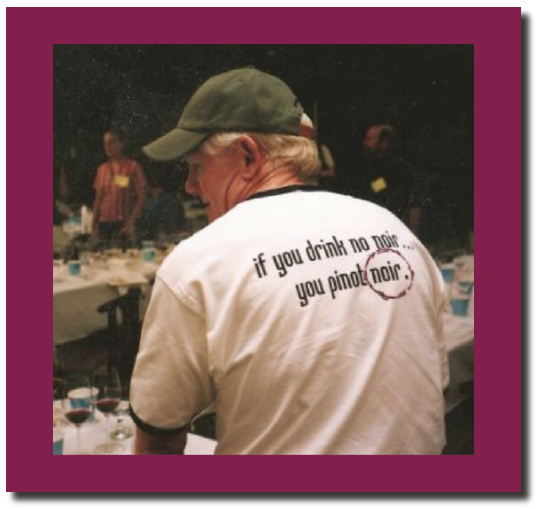 Some clarification of the status of the PinotFile is in order. Last August 1, I “retired” with the intention of spending more time drinking Pinot Noir than critiquing Pinot Noir. By January, 2020, I felt the urge to review a limited number of wines that continued to arrive unannounced for review, to report on special Pinot Noirs I had drunk, and to review a select few wines that were submitted by invitation. In addition, there were extended articles that I always intended to write and publish but never had the time because of previous travel commitments and the plethora of submitted wines to review. This feature on Joe Rochioli, Jr., is an example. At this time, I am not accepting uninvited submissions of Pinot Noir and Chardonnay for review. I do respond to inquiries and there may be times when a window opens for select wine submissions. The website will continue to remain accessible for reference.
One final comment relating to the current Covid-19 pandemic. I recently came across this quote that struck me as very appropriate for the times and I wanted to share it: “Wine is life. It’s a daily celebration of the sensual and of our social being: a pleasure that exists to be shared. It’s one of the threads that hold our humanity together. So yes, even at this moment we continue to celebrate it, because it is one of the things that shared will surely help us through these dark times….Andy Neather, hernehillandy.tumbler.com. |